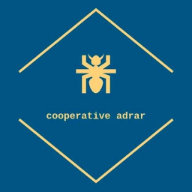The Adrar Rug Journal
Share
the Art of Moroccan Rug Making in Adrar: Tradition, Symbolism, and Craft
In the heart of southern Morocco, between the golden dunes and rugged mountains, lies Adrar — home to a proud community of artisans who continue one of Morocco’s oldest traditions: hand-woven rugs. Each rug is not merely a piece of décor; it is a story, a heritage, and a living piece of art.

The Weaving Tradition of Adrar
For generations, women of our cooperative have gathered around wooden looms, weaving stories passed down from their mothers and grandmothers.
Rug weaving in Adrar is a slow and sacred process — every knot tied by hand, every thread a reflection of patience, purpose, and pride.
Our artisans use locally sourced wool, often from the sheep grazing near the Anti-Atlas mountains. The wool is cleaned, carded, and hand-spun before being dyed with natural pigments derived from pomegranate skins, saffron, henna, and indigo.
.
Bringing a Piece of Adrar Into Your Home
A Moroccan rug is more than decoration — it is a story told in wool, a conversation between tradition and modernity.
When you unroll one of our rugs, you unroll a story of community, craftsmanship, and care.
🧵 Explore our collection: ShoppingMoroccanRugs.com
Discover the soul of Adrar, woven into every thread.

The Art of Moroccan Weaving
Moroccan rugs are known for their distinct textures, patterns, and symbolism. Each piece is unique, shaped by the hands and heart of its maker.
The weaving process begins with wool, which is carefully selected, cleaned, and hand-spun. The wool is often sourced from local sheep in the Anti-Atlas Mountains, known for its softness and durability.
Once the wool is ready, it is dyed using natural pigments — plant roots, leaves, berries, and even spices.
Traditional dyes include

ee
🧵 Inside the Loom: How Berber Women Weave Tradition
A Journey Into the Heart of Moroccan Craftsmanship
High in Morocco’s Atlas Mountains, where the air is crisp and the rhythm of life moves gently with the seasons, Berber women gather around their looms — tools that have carried their ancestors’ stories for centuries. Each rug they weave is more than fabric; it’s a language of symbols, colors, and emotions passed down through generations.
🌿 The Art of Weaving, Rooted in Heritage
For Berber women, weaving is not just craft — it’s culture. From an early age, daughters watch their mothers spin wool, dye fibers with natural pigments from saffron, henna, or indigo, and learn to bring patterns to life. Every design carries meaning: diamonds for protection, zigzags for water, and lines for the paths that connect mountain villages.
This art has survived through oral teaching, without written patterns. Each woman interprets her memories and dreams into a unique rug, creating one-of-a-kind pieces that cannot be repeated.
🧶 The Process: From Wool to Wonder
The process begins with the shearing of local sheep in spring. The wool is washed, carded, and spun into yarn by hand. Natural dyes — from pomegranate peel, madder root, or walnut shell — give the fibers their deep, earthy tones. Then the loom becomes a storyteller.
Working for days or even weeks, artisans weave line by line, knot by knot. The rhythm of the loom echoes the music of the mountains — steady, patient, and alive.
💫 The Meaning Behind Every Thread
Each rug is like a diary written in wool. Patterns may mark a family celebration, a harvest, or the birth of a child. Bright reds express vitality, blues symbolize protection, and neutral tones recall the desert sands. No two rugs are ever identical — each one is a living memory of the woman who made it.
🌸 Empowering Women, Preserving Identity
In cooperatives like Adrar in the Atlas region, weaving is more than tradition — it’s empowerment. By creating and selling their rugs, Berber women gain independence and keep their culture alive. Each sale supports families, education, and the continuation of an ancient Moroccan heritage.
🏡 A Story in Every Home
When a handmade Moroccan rug finds a place in your home, it carries more than beauty — it carries history, resilience, and the warmth of the hands that made it. It’s not just décor; it’s a bridge between worlds — from the mountains of Morocco to your living room.
✨ Discover more stories from the Atlas Mountains at Cooperative Adrar’s Blog
Follow us on Instagram for daily inspiration: @cooperative_adrar
Everything You Need to Know About Moroccan Rugs
Moroccan rugs are truly distinctive—instantly recognizable for their elegance, warmth, and authenticity. Handwoven by skilled artisans, each piece tells its own story through intricate patterns and traditional symbols that have been passed down for generations.
For centuries, Moroccan rugs have been a proud part of the country’s cultural heritage. Their history dates back to the 16th century, when Berber tribes began weaving rugs as part of their nomadic lifestyle. Each tribe developed its own signature style, colors, and motifs—giving rise to the famous regional designs such as:
- Beni Ourain
- Azilal
- Boucherouite
- Beni Mrirt
Every rug carries the identity of its origin, reflecting the soul and creativity of the weaver. Today, these handmade Moroccan rugs are more admired than ever, loved worldwide for their beauty, craftsmanship, and cultural depth.
If you’re passionate about authentic craftsmanship and want to learn more about the history and types of Moroccan rugs, keep reading—Cooperative Adrar will guide you through everything you need to know about these timeless works of art.

